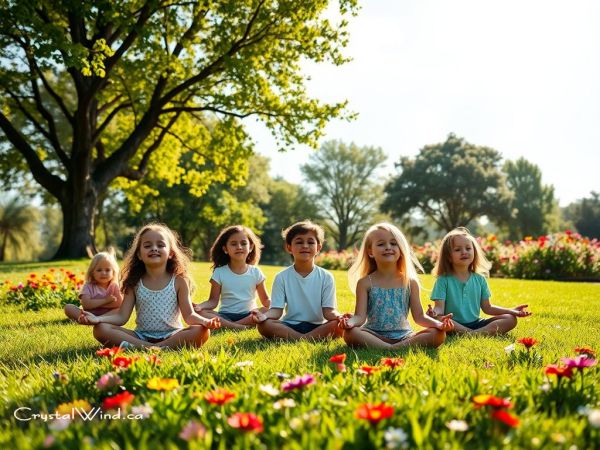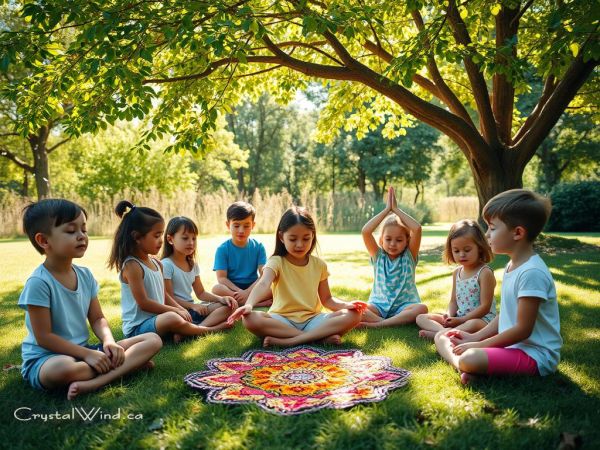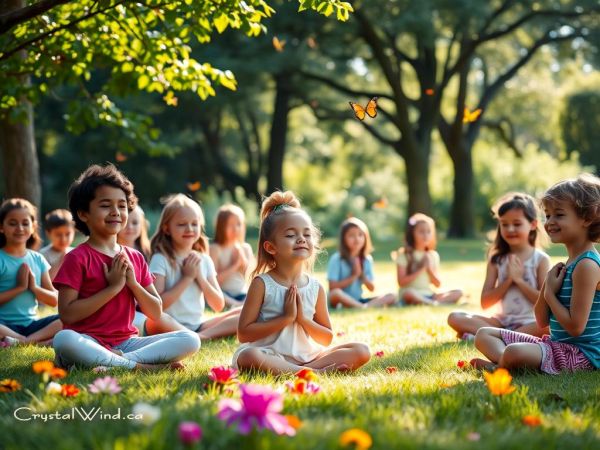Meditation for Kids: Simple Ways to Find Inner Peace
- Details
- Written by And-El
- Views: 1151

Did you know over 80% of kids today face a lot of stress and anxiety?
Our fast-paced, tech-filled world makes it key to teach our young ones how to find peace and emotional strength. Meditation is a simple yet powerful tool for kids, helping them discover themselves, focus better, and feel happier.
This article explores how meditation can change a child's life. We'll look at easy methods and ways for parents, teachers, and caregivers to help kids relax. From breathing exercises to movement activities, we'll show how to help kids grow emotionally strong and find their inner peace.
Understanding the Benefits of Meditation for Kids
As parents, we're always looking for ways to help our kids feel their best. Meditation, often seen as an adult practice, is great for kids too. It helps with stress relief for children, emotional regulation for kids, and focused attention activities for youth. This can lead to many benefits for their health, mind, and schoolwork.
Physical Health Benefits for Children
Meditation can make kids healthier in many ways. It can lower blood pressure, boost the immune system, and help with sleep. It teaches kids to handle stress and anxiety better, leading to better health overall.
Mental and Emotional Advantages
Meditation offers deep mental and emotional benefits for kids. It helps them become more aware of themselves, manage their feelings, and be stronger. It can also reduce depression and anxiety, and improve focus and thinking skills.
Academic Performance Improvements
Meditation can also help kids do better in school. It improves focus, attention, and memory. Studies show that kids who meditate often get better grades and do well on tests.
As parents, making our kids' well-being a priority is key. By teaching them meditation, we help them with stress relief for children, emotional regulation for kids, and focused attention activities for youth. This way, they can do well in all areas of life.
Creating a Calming Space for Young Meditators
Creating a special area for kids yoga and calm exercises can really help them with mindfulness. When kids have a quiet, inviting place for meditation, they tend to enjoy it more. This makes them more focused and excited about the practice.
Begin by picking a quiet spot in your home away from distractions. Let your kids help decorate it with soft colors, comfy cushions, and things from nature. This makes them feel like they own the space, making it more fun for their kids yoga and meditation.
Adding elements of calm down exercises for kids can make the space even more welcoming. Think about putting in kid-friendly yoga mats, blocks, or other tools that spark their curiosity. The aim is to create a place that's both calming and exciting. Here, kids can find peace and learn about their feelings through movement and breathing.
"When children have a dedicated space to practice mindfulness, they are more likely to develop a lifelong appreciation for the benefits of meditation."
The secret to a great meditation space for kids is to make it reflect their own interests and personalities. By letting them help design it and meet their needs, you build their excitement and sense of ownership. This encourages them to return to their peaceful spot again and again.
Simple Breathing Exercises for Children
Introducing breathing exercises for young minds - simple yet effective techniques to help children cultivate a sense of calm and focus. These children's relaxation techniques are designed to empower young individuals with tools to manage stress, enhance their mental well-being, and improve their overall academic performance.
Belly Breathing Technique
The belly breathing technique is a great starting point for children to learn the art of mindful breathing. Encourage your child to sit or lie down comfortably, placing one hand on their belly and the other on their chest. Instruct them to slowly inhale through their nose, feeling their belly rise, and then exhale through their mouth, allowing their belly to fall. Practicing this simple exercise can help children regulate their breathing and promote a state of relaxation.
Rainbow Breath Practice
For a more engaging breathing exercises for young minds experience, try the rainbow breath practice. Invite your child to imagine a vibrant rainbow appearing in front of them. As they inhale, ask them to visualize the color red, followed by orange, yellow, green, blue, indigo, and violet on the exhale. This colorful breathing exercise encourages children to focus on their breath while exploring their imagination.
Cloud Counting Exercise
Bring a sense of playfulness to children's relaxation techniques with the cloud counting exercise. Encourage your child to lie down, gaze up at the sky, and silently count the clouds passing by. This simple activity helps children shift their attention from their thoughts to the natural world, promoting a state of mindfulness and serenity.
Incorporating these breathing exercises for young minds into your child's daily routine can have a profound impact on their physical, mental, and emotional well-being. Empower your little ones to find inner peace and cultivate a lifelong practice of mindfulness.
Mindfulness Activities for Different Age Groups

Teaching mindfulness to kids can greatly improve their health and happiness. But, we need to adjust our methods for each age group. This section will show you fun mindfulness activities for kids of all ages.
Little ones can start with easy mindfulness for children exercises like "Belly Breathing" and "Rainbow Breath". These help them learn to focus and control their feelings. As they get older, focused attention activities for youth like "Cloud Counting" and "Mindful Walking Adventures" can keep them engaged and aware.
"Mindfulness is not about changing who you are, but about noticing who you are."
Teenagers can try more advanced techniques like guided imagery and visualization. These help them think deeply and manage their emotions. Activities like "Magic Garden Visualization" and "Peaceful Animal Friends Journey" are great for teens facing big challenges.
By tailoring mindfulness to each age, we can help kids of all ages grow and learn. The goal is to make mindfulness fun and meaningful for each stage of development.
Guided Imagery and Visualization Techniques
Meditation for kids can be made better with guided imagery and visualization. These methods spark the imagination, leading to calm and peace. Here are three fun exercises to help kids find their inner calm.
Magic Garden Visualization
Picture a beautiful garden with colorful flowers, tall trees, and a quiet stream. Ask kids to imagine walking through this peaceful place. They can see, hear, and smell all around them.
As they walk, they might meet friendly animals or find a cozy spot for thinking. This guided imagery for little ones takes them to a calm place in their mind.
Peaceful Animal Friends Journey
Some kids like to connect with animals. In this exercise, they can choose an animal friend like a deer, owl, or dolphin. They go on a calm journey with their animal, seeing beautiful places and doing calm down exercises for kids.
Having their animal friend makes them feel safe and curious.
Floating Cloud Experience
Imagine kids floating on a soft, white cloud. They can watch the world below, feeling calm and detached. Tell them to breathe slowly and let go of worries.
This guided imagery for little ones helps them feel peaceful and mindful.
By using these calm down exercises for kids, they can enjoy the benefits of guided imagery. It helps them feel better physically, mentally, and emotionally.
Incorporating Movement with Kids Yoga
Meditation for kids doesn't have to mean sitting all the time. Kids yoga brings movement into meditation, making it fun and engaging. It combines yoga poses with mindfulness, helping kids use their energy in a positive way.
Simple yoga for kids makes meditation fun and active. Kids yoga lets them discover their bodies and feelings through fun movements. It helps them become more aware of their bodies and minds, all while having fun.
Activities like sun salutations or tree poses add a physical layer to kids yoga. This mix helps kids find peace and learn to control their emotions through movement and mindfulness.
Adding kids yoga to meditation keeps kids interested and full of energy. This approach helps them love mindfulness and self-care for life.
Making Meditation Fun: Games and Activities
Helping kids learn emotional regulation and mindfulness can be fun. We can make meditation exciting for them by adding games and activities. These activities mix emotional regulation for kids and mindfulness for children in a way that's full of wonder.
Mindful Walking Adventures
Start a mindful walking adventure with kids. Ask them to pay attention to their feet touching the ground, the wind on their skin, and the world around them. This helps them feel calm and focused.
Sound Awareness Games
Play games that focus on sound with kids. Have them close their eyes and try to identify different sounds. This game sharpens their hearing and teaches them to stay present.
Emotional Expression Activities
Let kids express their feelings through art. Encourage them to draw, paint, or sculpt what they're feeling. This helps them understand and manage their emotions, teaching them about emotional regulation for kids.
By adding fun elements to meditation, we make it enjoyable for kids. This helps them learn mindfulness for children and how to take care of their feelings.
Building Daily Meditation Routines

Starting a meditation for kids practice can change a child's life. It helps with stress relief for children and emotional health. By adding short meditation times to a child's day, parents can teach them to stay calm and self-controlled.
Begin with small steps and make meditation a part of daily life. Experts suggest 5-10 minutes in the morning or before bed for breathing or guided visualizations. Even a short time can help kids manage feelings, focus better, and find peace.
"Consistency is key when building a meditation habit with children. Make it a daily practice, even if it's just for a few minutes at a time."
Parents should join in on meditation with their kids. This makes it a family activity. It strengthens the bond and shows the value of meditation.
As kids get older, they can do longer and more complex meditations. Older kids might like guided imagery or simple yoga. Make sure the meditation fits the child's age, attention span, and interests, keeping it fun.
Adding meditation for kids to daily life brings many benefits. It helps with stress relief for children, improves school work, and boosts emotional smarts. It's a great way to invest in a child's happiness and well-being, benefiting them for years.
Using Technology: Best Meditation Apps for Children
In today's world, parents can use technology to help their kids meditate. Many mobile apps are made just for kids. They have fun features that teach mindfulness.
Age-Appropriate App Recommendations
The Calm app is great for little ones. It has cute characters and stories like "Sleepy Sloth" and "Brave Bunny." Headspace for Kids has short sessions and cool animations to teach kids to breathe and focus.
Older kids might like the Stop, Breathe & Think app. It lets them create their own avatar and play games that teach mindfulness.
Screen Time Balance Tips
Technology is helpful, but it's key to balance it with real-life activities. Experts say to set limits on screen time. They also suggest trying meditation without screens, like walking, yoga, or imagining nature.
This mix helps kids develop a strong meditation habit. It's good for their body, mind, and heart.
The information provided in this article on "Meditation for Kids: Simple Ways to Find Inner Peace" is intended for educational and informational purposes only. It is not a substitute for professional medical advice, diagnosis, or treatment. Parents and guardians should consult with healthcare professionals before starting any new practices or if they notice any adverse changes in their child's behavior or well-being. While meditation can offer many benefits, it should not be used as a sole treatment for mental health issues or other conditions. Always ensure that meditation is practiced in a safe, supervised environment suitable for children. The authors and publishers of this content do not accept liability for any consequences arising from the application of this information.
This article is written exclusively by And-El of CrystalWind.ca © 2024 crystalwind.ca. You may share my articles as long as you provide proper credit to the author, include a link to the original article, and do not alter the content. Commercial use is prohibited without permission.
And-El is the owner and founder of CrystalWind.ca, a popular online platform dedicated to spiritual growth, metaphysical knowledge, and holistic wellness. And-El created CrystalWind.ca to provide a space for seekers to explore topics like astrology, meditation, ascension, and alternative healing. And-El's vision is to inspire and guide individuals on their spiritual journeys by sharing wisdom from various traditions and philosophies. Through CrystalWind.ca, And-El has fostered a community where people can connect, learn, and evolve.
Liked this article? Dive deeper into personal growth and wellness! Check out CrystalWind.ca for spiritual wisdom or explore AromaWorx.ca for natural well-being tips. Spread the positivity—share this with friends on their happiness journey!
Let’s Chat! Drop Your Thoughts Below! ![]()
Latest Articles

Imagine a world of inspiration and healing, free for all—made possible by YOU!
Donate Now—Ignite the Magic at CrystalWind.ca!

Epilepsy - Finding A Cure
Your donation can make a difference!
Help us find a cure – donate now!
Unlock Your Light: Join Lightworkers Worldwide on CrystalWind.ca!
Quake Watch
Follow Us!
Who is Online Now
We have 34021 guests and no members online
Featured This Month
The Time of No Time: Beltane!
Around the medicine wheel of life we go, from season to season (solstice to ... Read more
Sun in Taurus
Sun in Taurus April 21 through May 21 An Overview of Sun Sign Characteristi... Read more
Cartomancy - Fortune Telling Using Playing C…
Cartomancy is the act of divining using cards. Divining means to find out by... Read more
Bright Beltane Blessings!
The wheel turns to Beltane, also known as Mayday, marking the beginning of S... Read more
The Crystal Wind Oracle Card Deck
The Crystal Wind Oracle™ The Crystal Wind Oracle Myth & Magic Card D... Read more
Frogs Return Moon
Beaver – Chrysocolla - Blue Camas – Blue April 20 – May 20 The Frogs Retur... Read more
The Seven Chakras and their Meanings
If you could imagine chakras as circles of energy, flowing all the way throu... Read more
Taurus Mythology
The Taurus Myth The story of Taurus is most vividly tied to the tale of Zeu... Read more































































































































































